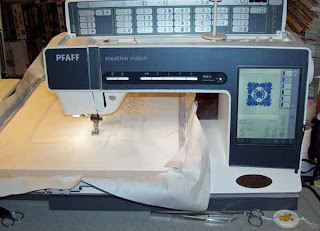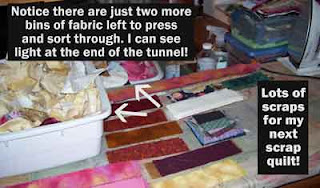 I've owned a number of sewing machines over the years and enjoyed sewing on every one of them. My first was a $99 straight stitch/zig zag White around my senior year of high school. It was all I could afford at the time and still have money to buy some fabric. Later as I got older, married and had kids I purchased another one that had more decorative stitches. I can remember wanting so badly to get a machine that had alphabets for the longest time. Eventually I purchased one that had more decorative stitches and was thrilled that it also had alphabet letters and a memory. After sewing tiny (6mm-9mm letters) onto everything I could work it into I began to day dream about the possibility of getting an embroidery machine. At the time there was no way I could swing it financially so made do with what I had for a long time. Then many more years down the road when I started working at a local sewing machine dealership I was in heaven to finally get an opportunity to own a Husqvarna Viking sewing/embroidery machine combination. I've since then graduated to the top-of-the-line Pfaff with all the bells and whistles and huge embroidery frame size.
I've owned a number of sewing machines over the years and enjoyed sewing on every one of them. My first was a $99 straight stitch/zig zag White around my senior year of high school. It was all I could afford at the time and still have money to buy some fabric. Later as I got older, married and had kids I purchased another one that had more decorative stitches. I can remember wanting so badly to get a machine that had alphabets for the longest time. Eventually I purchased one that had more decorative stitches and was thrilled that it also had alphabet letters and a memory. After sewing tiny (6mm-9mm letters) onto everything I could work it into I began to day dream about the possibility of getting an embroidery machine. At the time there was no way I could swing it financially so made do with what I had for a long time. Then many more years down the road when I started working at a local sewing machine dealership I was in heaven to finally get an opportunity to own a Husqvarna Viking sewing/embroidery machine combination. I've since then graduated to the top-of-the-line Pfaff with all the bells and whistles and huge embroidery frame size. I've been sewing for a long, long time. Through the years I've picked up many new techniques and added new ones whenever the sewing industry introduced new features and functions on machine. The products including the machines, the patterns and books, classes on VHS, CD, DVD and now on-line have all become more affordable and more sophisticated.
While working in the sewing machine industry I've met lots of wonderful people. Many new sewers starting out would love to purchase upper-line machines but can only afford to start with a hobby type machine.
I categorize machines in one of these two designations. Hobby machines usually come with a one year (or less) warranty, are made of mostly plastic parts, have smaller motors, smaller stitch size (4.5mm-6mm) and typical 10 year average life span as a home sewing machine. Keep in mind a lot of home sewers sew only occasionally and usually with light weight fabric like cotton. You'll find hobby machines at big box retail stores as well as many sewing machine dealerships.
On the other side of the spectrum are upper-line machines. Upper-lines usually come with 2 or more years warranty through a sewing machine dealership, have the major components made from metal rather than plastic, have bigger motors, bigger and wider stitches (9mm-40mm or more), can sew through heavier, multiple layers of fabric (such as 12 layers of denim and garment weight leather), have many more features and typical life expectancy of 20 years of home sewing.
For the first three-fourths of my life I sewed on a hobby type machine. Lots of sewing! These machines are good, but upper-line is so much better. I didn't realize this until I actually sat down and did some real sewing on an upper-line. Now I would never go back to a hobby, unless that was all that was left in the world - I certainly wouldn't give up sewing for lack of an upper-line machine!
When it comes to machines, my theory is: "You can get anything you want, you just have to pace yourself." Many dealerships have trade-up programs that allow you to move up to the next level in a manner that's a little easier on the pocketbook. It's worth checking out. In the meantime, no matter what machine you are currently working with . . . treat it well. Give it a good cleaning on a regular basis. Oil it every 8-10 hours or as called for in the manual. Don't sew over pins, and change your needle often. You'll enjoy sewing more when things are running smoothly. You can plan to trade-up to the next level when you make the opportunity happen. Your machine will reward you with many pleasurable sewing hours ahead.


